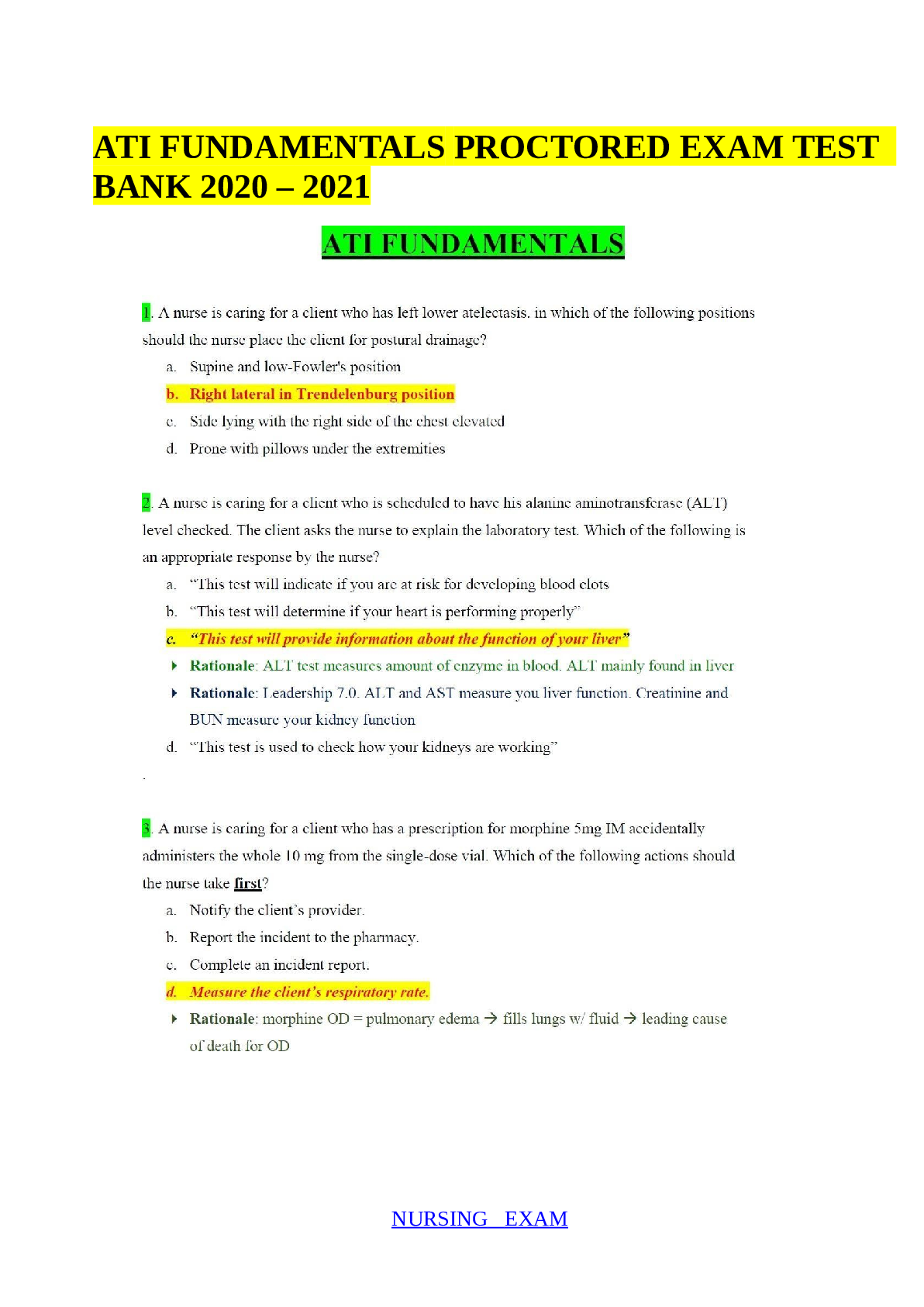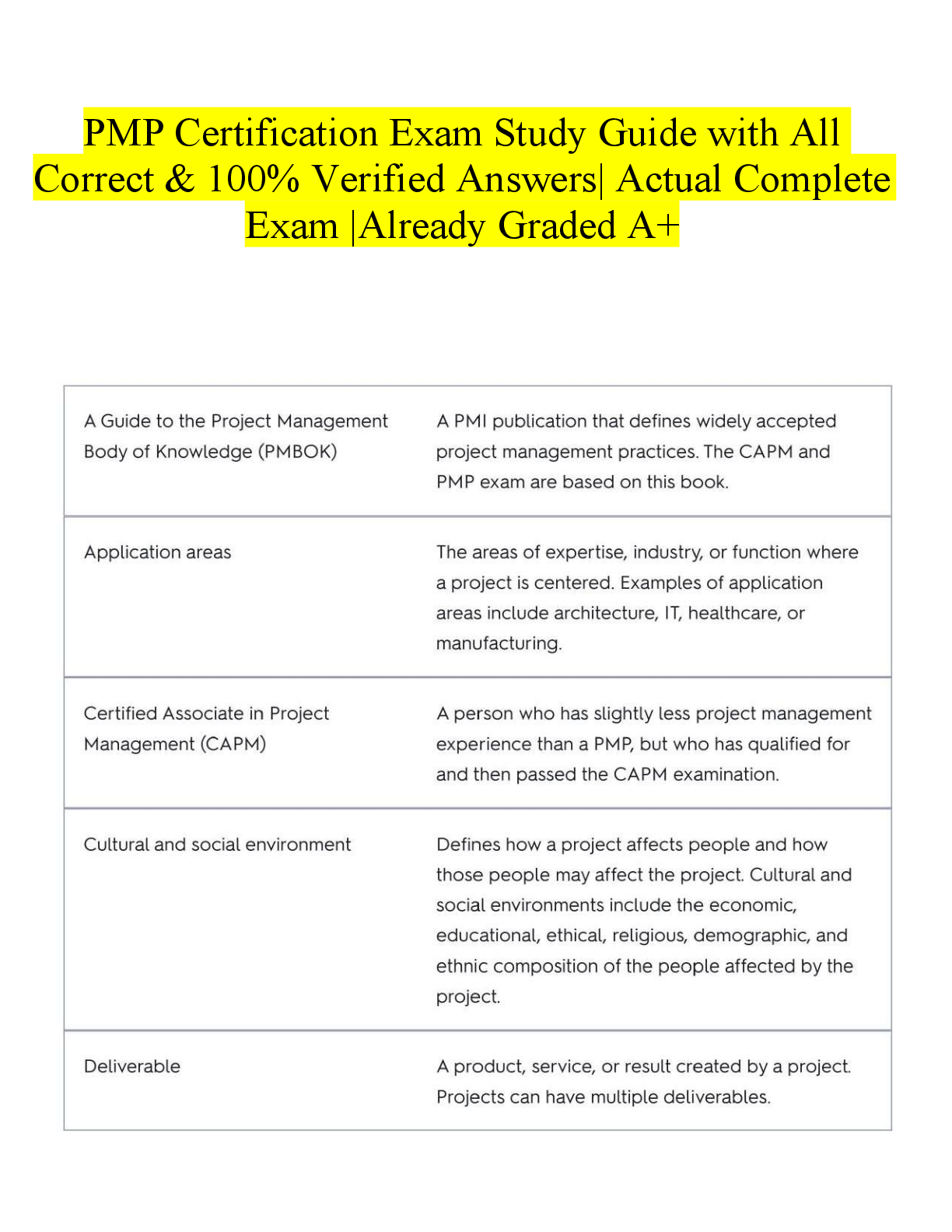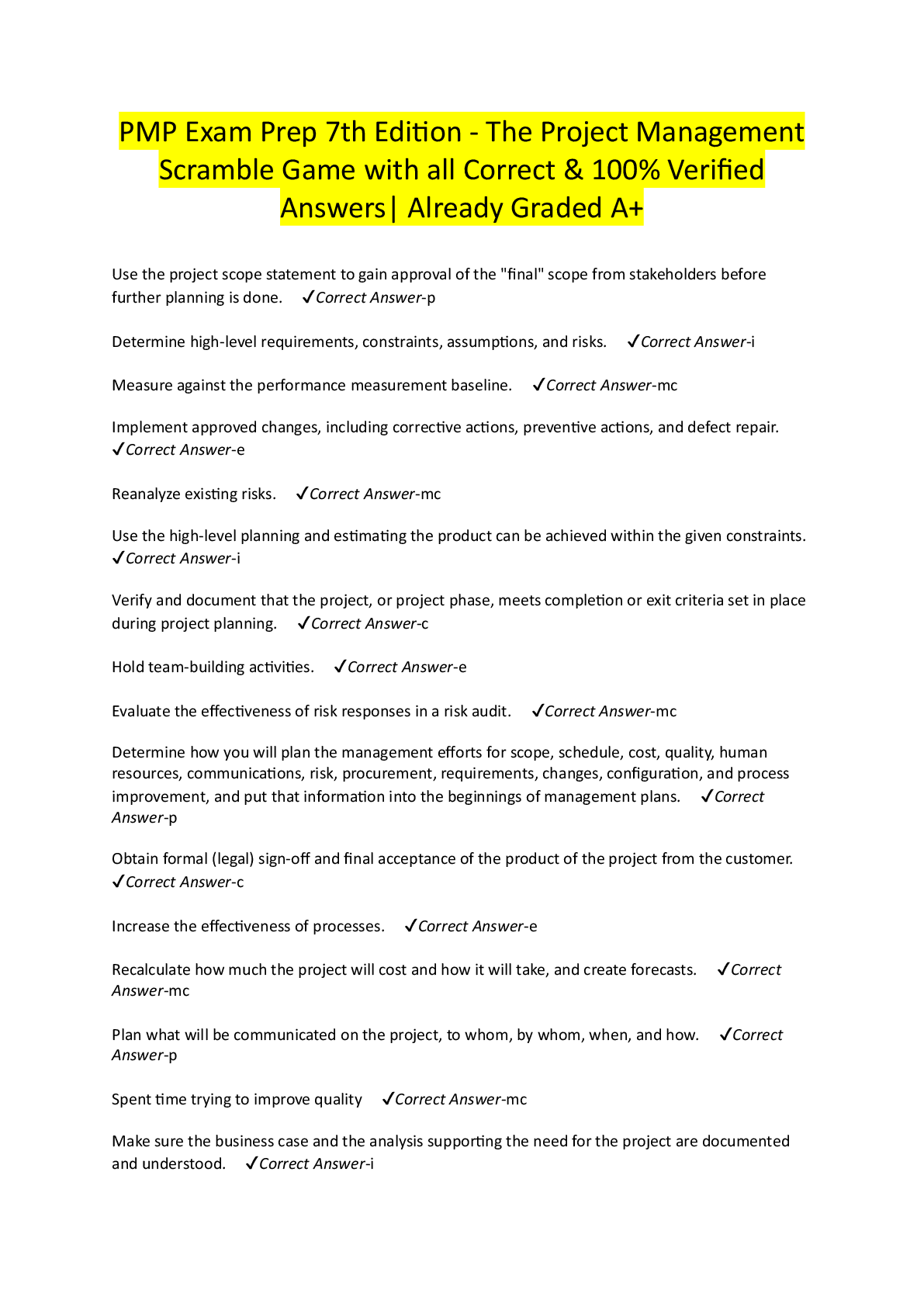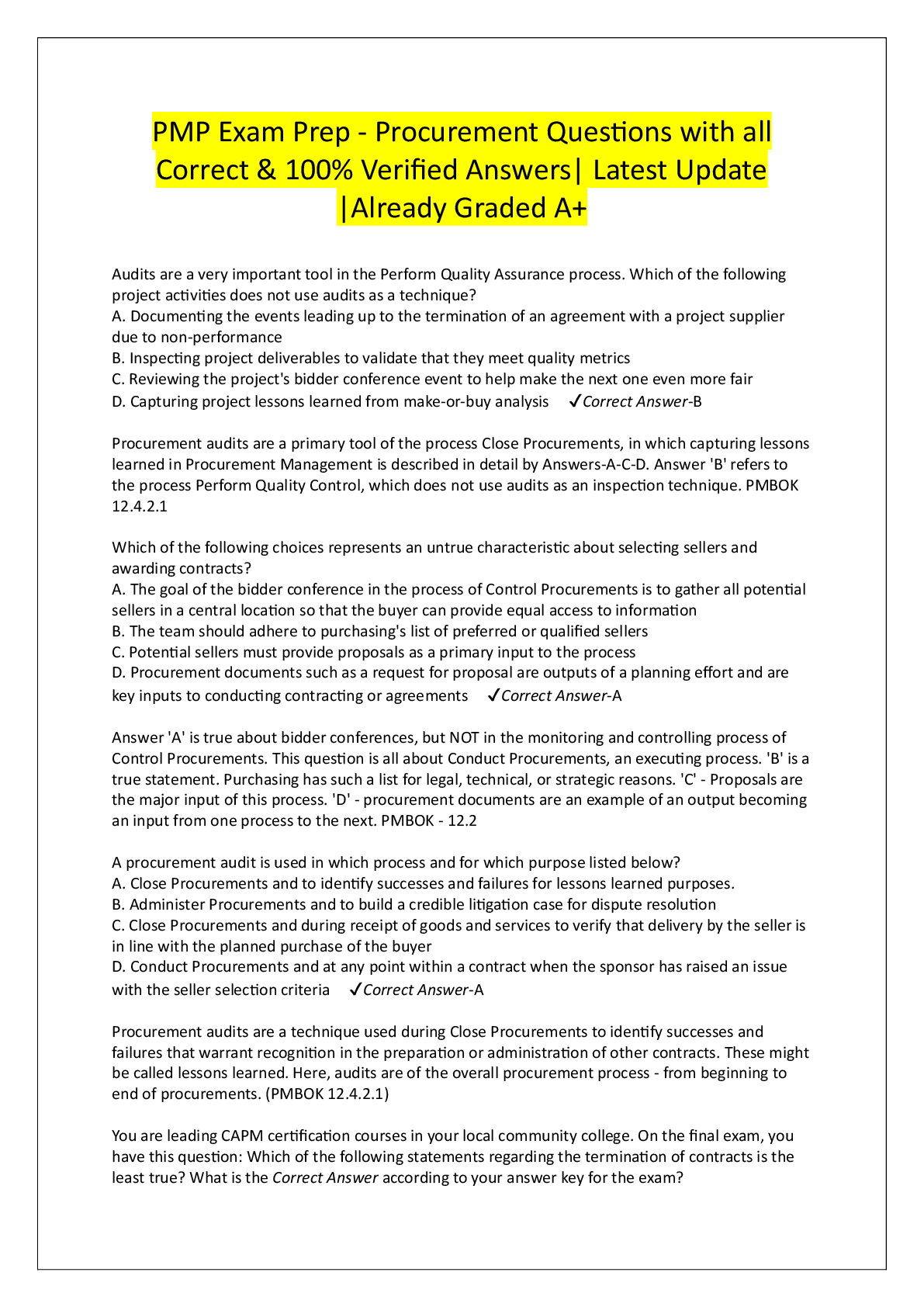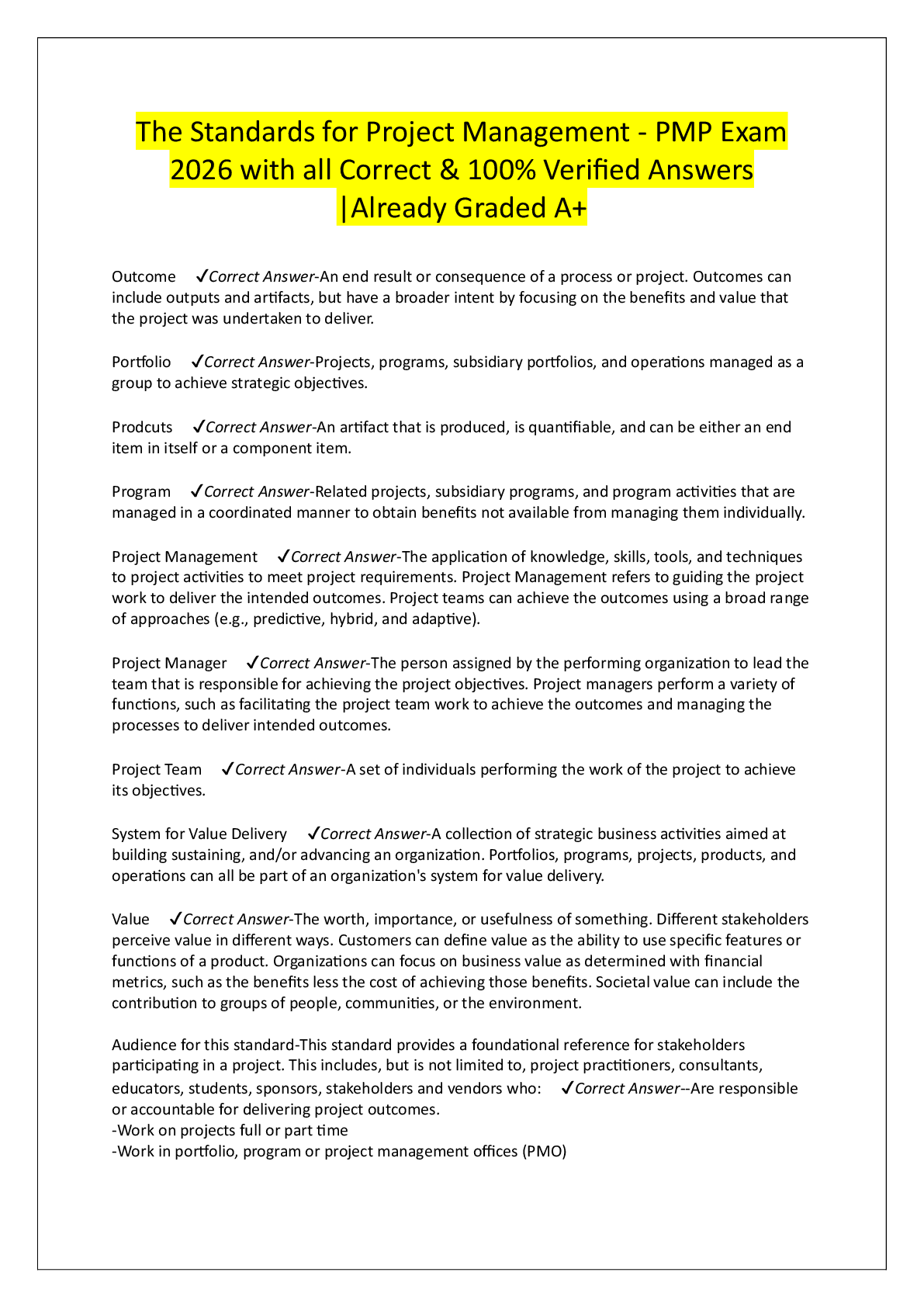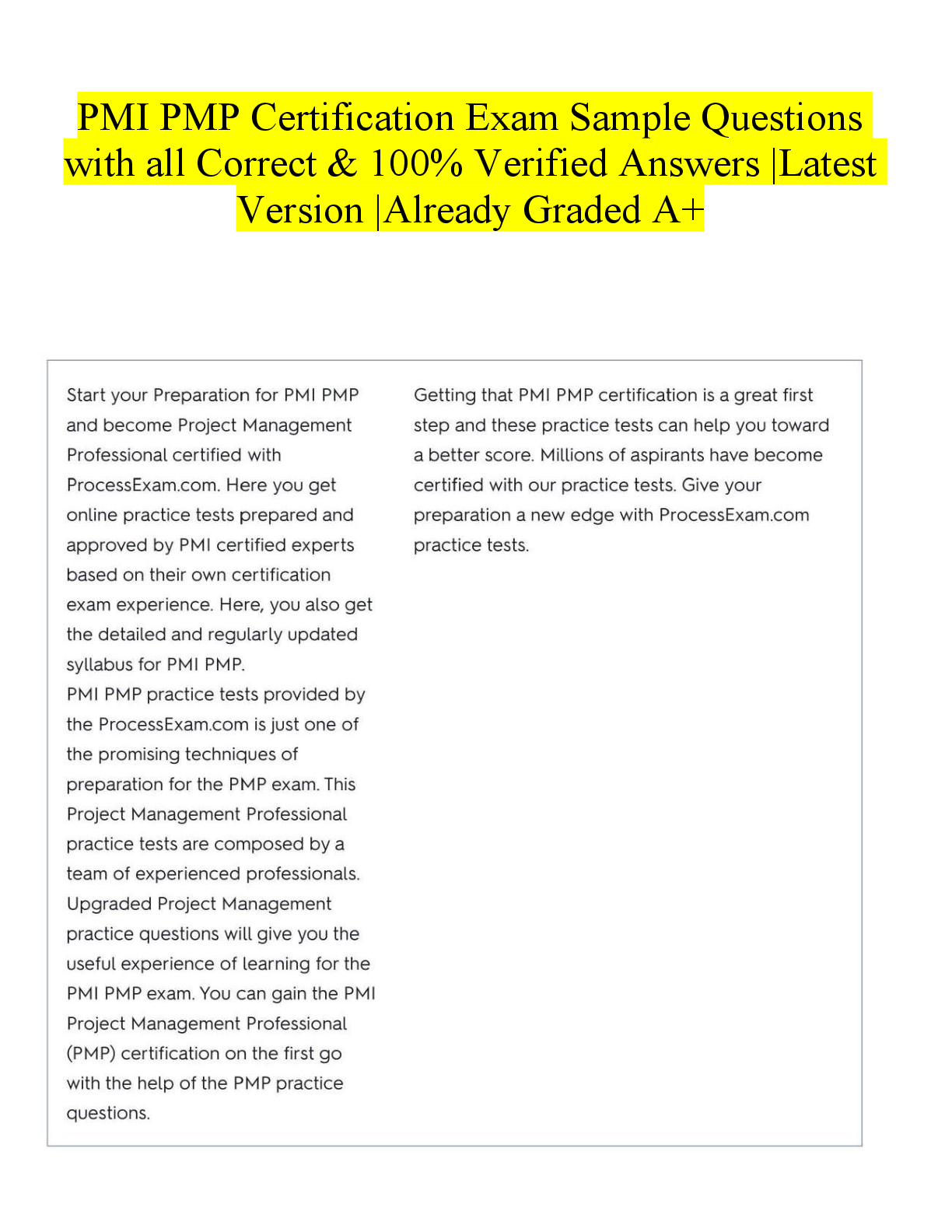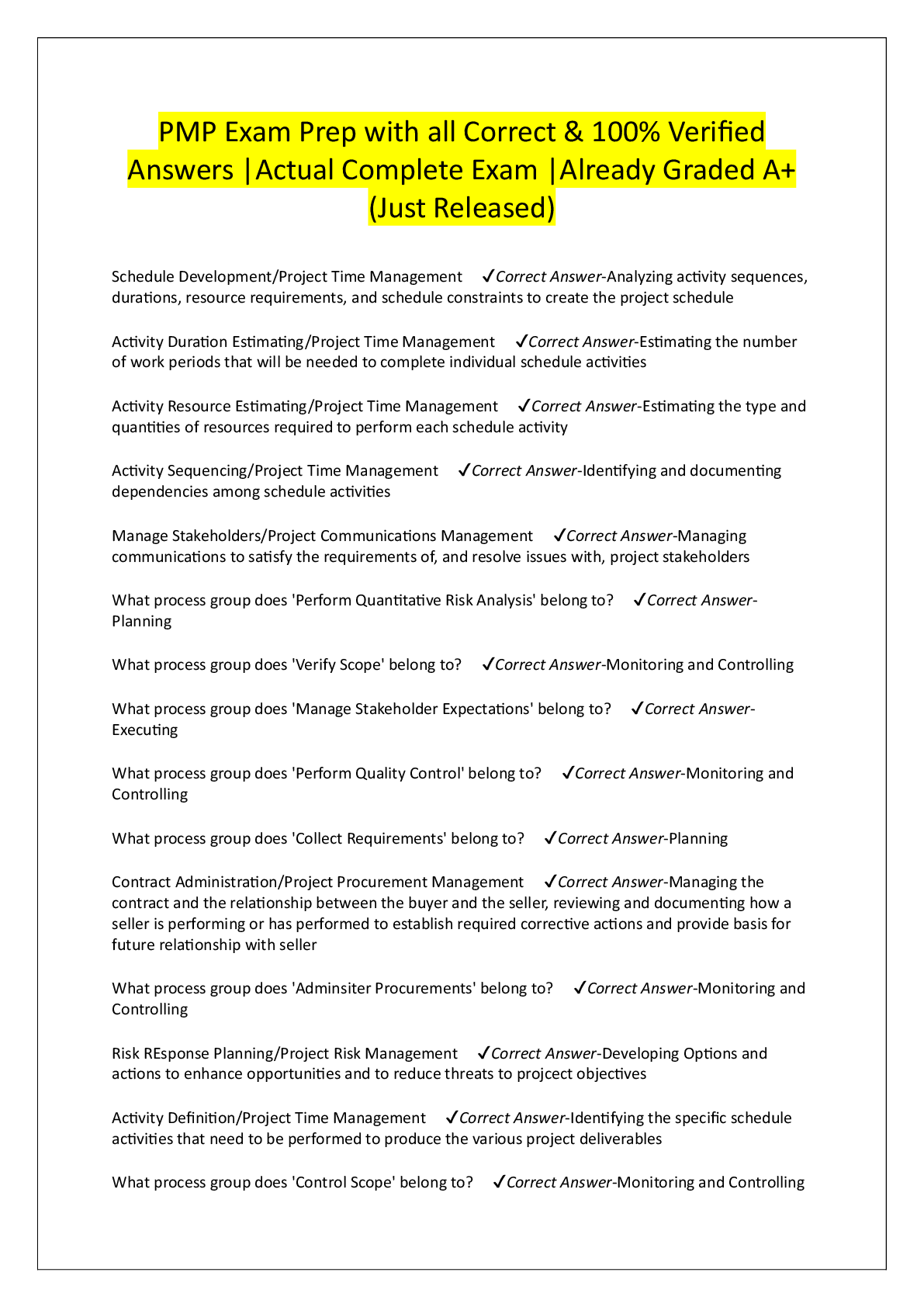Art > EXAM > Chapter 6 Teachers' Roles in Fostering Creative Thought and Expression Questions And Answers (Veri (All)
Chapter 6 Teachers' Roles in Fostering Creative Thought and Expression Questions And Answers (Verified Solutions)
Document Content and Description Below
Chapter 6 Teachers' Roles in Fostering Creative Thought and Expression Directions: Choose the correct answer by highlighting your choice. 1) A teacher's role in fostering creative thought in ... cludes: A) offering children many opportunities to engage in creative endeavors B) creating units of learning that have little meaning to children C) providing choices, but not support D) setting inflexible rules E) being closed to new ideas 2) An appropriate strategy for resolving group entry disputes is to: A) ask children to share materials or toys B) reassure children they will get a turn C) use the "You can't say you can't play rule" D) set reasonable limits on play E) discourage children from bringing toys from home 3) Toddlers' conflict is typically related to: A) joining groups during play B) differences over rule-bound games C) possession of toys D) violent play E) others forcing them to play "their way" 4) Children develop prosocial behavior when they: A) see adults in conflict B) see adults favor one child over another C) see selfish, self-centered adults D) all of these E) none of these 5) In the Reggio Emilia Schools in Italy, teachers are: A) autocratic B) authoritarian C) democratic D) permissive 6) Conflict is: A) something teachers should prevent from happening B) something teachers should handle immediately C) something that can enhance children's social development D) an unnatural part of daily life E) always intentional 7) Creative teachers view themselves as: A) decision-makers B) problem-solvers C) risk takers D) A and B E) A, B, and C 8) In conflict situations: A) all children should be punished B) focus on what can be done C) children should not think about the problem before going to the teacher D) teachers should step in and determine who is at fault E) try to unravel the whole situation before attempting to solve it 9) Children who are in this type of classroom feel most secure, self-assertive, and self-controlled. A) democratic B) autocratic C) permissive D) authoritarian 10) The view that children gradually build their own understandings about and knowledge of the world through active participation best describes: A) Constructivism B) Behaviorism and social learning C) Humanism D) Socialism 11) Autocratic adults tend to: A) Understand children's limits and abilities B) Have high expectations of their students C) Discourage individuality in their students D) Present an inconsistent environment E) Show flexibility in rules and standards 12) Both concept building and problem solving are aspects of children's: A) Socioeconomic status B) Creative growth C) Facilitation D) Mediation E) Physical development 13) Which of the following is (are) considered to be the most powerful influence(s) on children's cooperative and self-responsible behaviors? A) Watching significant adults model prosocial behavior B) Working with an autocratic teacher C) Being punished for misbehavior D) Being rewarded for all appropriate behavior 14) ________ is child-directed play that occurs when children actively explore and experiment with ideas and materials in a planned, challenging environment that meets curriculum goals. A) Play B) Creative play C) Guided play D) Structured play E) Unstructured play 15) An appropriate strategy to deal with conflict for elementary children includes: A) opportunities for peer acceptance B) opportunities to participate in rule governed games C) model constructive ways of dealing with conflict and problems D) A and B E) A, B, and C 16) While helping fourth-grade students with reading comprehension difficulties, a teacher tries to think of an approach that would support them in this important learning. What is one effective instructional strategy to use? A) Let the students complete workbook pages in small groups rather than individually. B) Identify pairs of students, one of whom is an accomplished reader and the other, a child with comprehension difficulties. Give the former an explicit strategy for pausing at natural breaks in the story to ask the latter student to ask a question, explain an idea, or summarize what has happened thus far. C) Have students work independently on workbook pages and provide them with an answer key to check their own work. Use the results to form reading groups. D) Allow students to choose whatever skills pages they would like to complete and have a classroom aide check them. 17) During a unit on United States geography, a fourth-grade teacher wants to include student projects. How can creative projects be incorporated into geography? A) Have students design a project showcasing the interesting geographical characteristics of a region. B) Have each student complete a written report and read it aloud to the entire class. C) Have students complete an Internet search and find an assortment of pictures from each geographic region. D) Show students a virtual field trip of different geographic regions and have them vote on their favorite destinations. 18) After reading a series of books by the same author, a first-grade teacher plans to let children select one book with which to demonstrate their comprehension of story elements. Which of the following would be an effective way to use assessment creatively? A) Have children exchange papers and grade one another's work. B) Give students a multiple-choice test that is very similar in format to the state mandated tests. C) Grade the children's work and send it home for families to see. D) Let children participate in the design of a set of criteria for evaluation that will be the basis for the teacher's scoring rubric. 19) Shawn, a first-grader on the autism spectrum, has encyclopedic knowledge of certain subjects, such as dinosaurs. Part of Shawn's individualized education plan (IEP) is to help him interact with peers during group activities. Which of the following is likely to be most effective? A) Wait for Shawn to show an interest in working with other students and gradually increase the amount of group work. B) Choose a high-interest topic for Shawn and assign him a role that will earn the respect of his peers, such as "dinosaur fact finder." C) Let him complete independent activities on the computer while all of the other students are collaborating. D) Insist that Shawn join a group and complete the activities with the rest of the class and warn him that he is being graded on cooperation. 20) Five-year-old Svetlana is on a behavior modification plan in school. She knows that when she gets upset she goes to a quiet corner of the classroom to calm down. But on the playground, she becomes frustrated by waiting for a turn to throw a ball and doesn't know how to respond in this context. Which of the following theories most strongly linked with this aspect of behavior? A) sociocultural theory B) surplus energy theory C) cognitive developmental theory D) eclectic theory 21) A teacher notices that a kindergartner seems distracted and appears to have difficulty concentrating. When she talks with the child privately, he says that he is "hungry and sleepy." Which theory would offer the most direct explanation for this behavior? A) Maslow B) Vygotsky C) Piaget D) Bandura 22) While meeting with families at an open house, a teacher told them that she respected and valued each and every one of the children in her class. She went on the say that she had high expectations for them, would be clear with the classroom rules, and held each child accountable for behavior. She also described how the environment of her class would allow children to make important choices and practice higher-level thinking skills. Which of the following is the category into which this teacher would be placed? A) permissive B) democratic C) autocratic D) dogmatic 23) A preschool class is asked to come up with ways to reorganize their toys because a few of the bins are overflowing. The class sits together and offers suggestions and ideas and then puts their plan into action. All the children help to organize the toys and have a sense of pride in what they have accomplished together. This is an example of: A) inquiry based learning B) guided play C) learning centers D) structured play 24) Use the following theoretical perspectives to answer the items below by matching theory/perspective to the classroom example of creative expression. A. cognitive developmental theory B. humanistic C. behaviorial D. social learning 1. ___D____ Offer many hands-on experiences. 2. ___B____ Praise children’s efforts, process, or accomplishments. 3. ___C____ Use I-messages. 4. ___A____ Model appropriate behavior. 5. ___D____ Listen actively. 25) Use the three basic styles of adult-child interactions to answer the items below. A. autocratic B. permissive C. democratic 1. ___C____ Students are empowered to be responsible for their own learning and actions. 2 ___A____ Uses an unbending set of rules to maintain control. 3. ___A____ Fosters resentful, rebellious interactions; develops children who have difficulty with peer interactions. 4. ___B____ An inconsistent environment with few or no limits placed on children. 5. ___C____ Teachers offer age-appropriate materials, encourage choice, have high expectations or the students, and respect their ideas. 6. ___C____ Projects a laissez-faire, uninterested attitude. 7. ___B____ Prepares the environment with choices and plenty of time for interactions. 26) Use the following choices to answer the items below. A. inquiry-based learning B. guided play C. projects D. all of these 1. ___B____ An in-depth investigation of something worth learning about undertaken by one or more children for as long as they maintain interest. 2. ___D____ Offer children opportunities to revisit the same materials and ideas many times. 3. ___C____ Spark children’s curiosity and promote divergent thinking. 4. ___A____ Emphasizes solving authentic problems and issues. 5. ___B____ Collaboration exposes children to different points of view and increases social interaction skills. Directions: Choose TRUE or FALSE for the statements below. 27) Teachers can guide children's creative growth by indirect or direct strategies. Answer: TRUE 28) Children's feelings about themselves influence their ability to solve problems. Answer: TRUE 29) Teachers should study and adopt the one theory of learning that best suits their needs and style. Answer: FALSE 30) Children learn social behavior by observing others in social settings. Answer: TRUE 31) Teachers should deal with all children in the same way. Answer: FALSE 32) Autocratic teachers generally foster students who are anxious, withdrawn, and apprehensive. Answer: TRUE 33) How teachers feel about themselves has little influence on children's behavior. Answer: FALSE 34) Creative teachers expect children to be responsible for their own learning by providing appropriate materials and guiding inquiry. Answer: TRUE 35) Very young children can be responsible for making choices and decisions. Answer: TRUE 36) Guidance techniques are not considered to be developmentally sequenced. Answer: FALSE 37) Spontaneous sharing is considered prosocial behavior. Answer: TRUE 38) Children with disabilities often gain a positive self-concept through participation in the arts. Answer: TRUE 39) An eclectic approach includes applying a variety of theories that fit your beliefs and help you make the best educational decision for children's creative thought and behavior. Answer: TRUE 40) Young children often cannot distinguish between intentional and unintentional behavior. Answer: TRUE 41) Good problems for young children are real, relevant, and have a single solution. Answer: FALSE 42) The goal of guiding children's creative growth is well-behaved children. Answer: FALSE 43) Teachers should be the center of control in the early childhood classroom. Answer: FALSE 44) Democratic teachers believe that children need firm but reasonable limits. Answer: TRUE 45) To help develop self-control, have children sit in a chair for five minutes when they demonstrate inappropriate behavior. Answer: FALSE 46) Providing choices for children confuses them. Answer: FALSE 47) Democratic teaching styles help children to feel a sense of security and increase self-sufficiency. Answer: TRUE 48) When teachers are implementing a Project, the project undertaken must focus on a subject for a minimum of one week. Answer: FALSE 49) Keeping children engaged in learning should not be a teacher's goal. Answer: FALSE 50) When teachers encourage children to use I-messages, they are supporting the theory of behaviorism. Answer: FALSE 51) According to the text, one fundamental classroom rule that helps children learn positive ways of dealing with each other is "You can't say you can't play." Answer: TRUE 52) Teachers should discourage the practice of children bringing items from home to school that they will not or should not share. Answer: TRUE 53) An eclectic approach means understanding and applying one theory that fits your beliefs. Answer: FALSE 54) Good problems require the child to modify, move, or transform the materials. Answer: TRUE 55) Children should have an active role in creating and monitoring classroom rules. Answer: TRUE 56) Teachers often overestimate the influence of their own upbringing and value system on guiding the creative behaviors of others. Answer: FALSE 57) Adults' interactions with children exert a minor influence on the way they express creative behavior. Answer: FALSE 58) In order to diminish children's power struggle disputes, keep track of turn-taking to ensure that every child really does get a turn. Answer: TRUE 59) Good problems help the child believe in his or her own problem-solving abilities. Answer: TRUE [Show More]
Last updated: 3 years ago
Preview 1 out of 7 pages

Buy this document to get the full access instantly
Instant Download Access after purchase
Buy NowInstant download
We Accept:

Reviews( 0 )
$17.00
Can't find what you want? Try our AI powered Search
Document information
Connected school, study & course
About the document
Uploaded On
Feb 22, 2021
Number of pages
7
Written in
All
Additional information
This document has been written for:
Uploaded
Feb 22, 2021
Downloads
0
Views
170

.png)




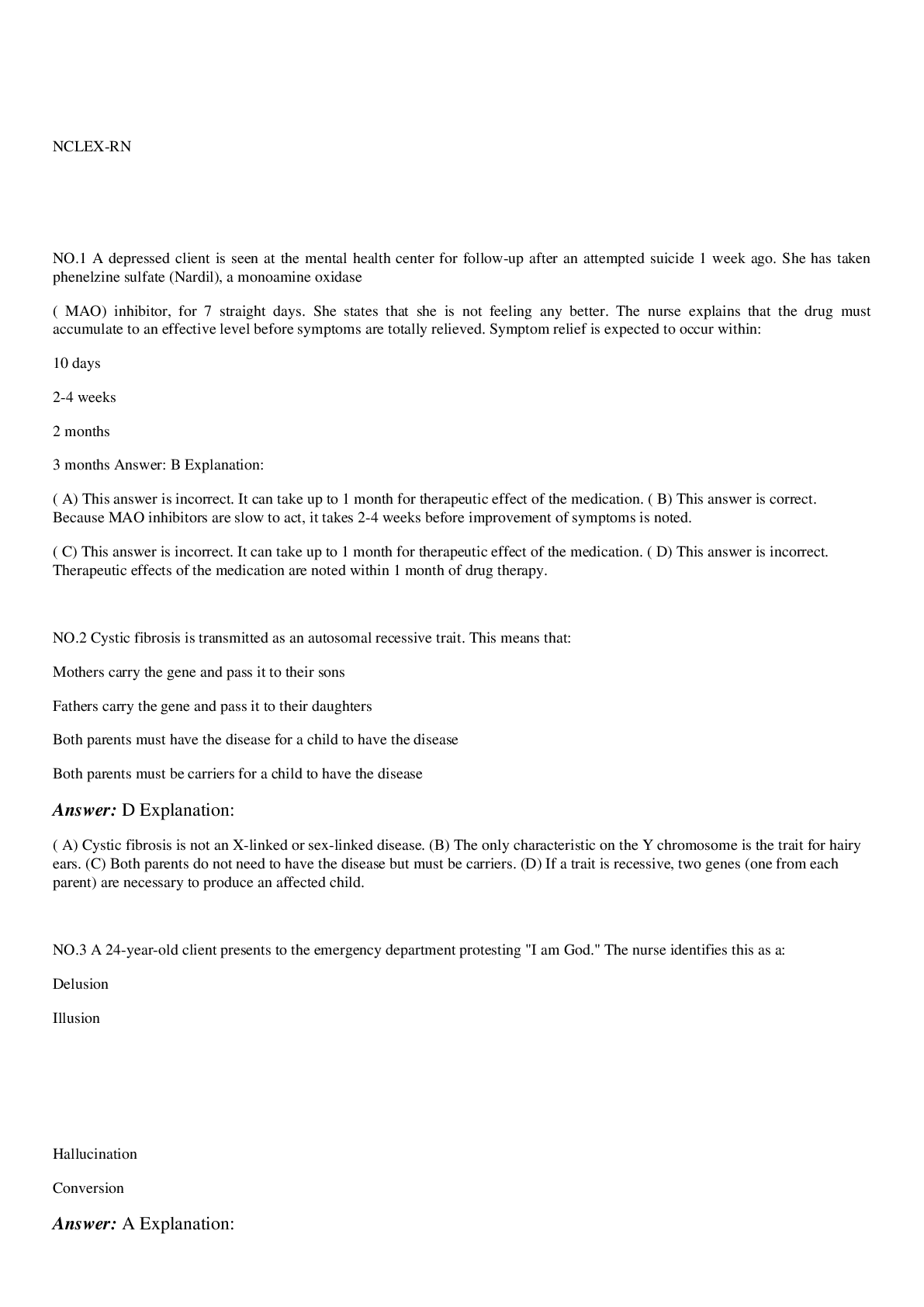
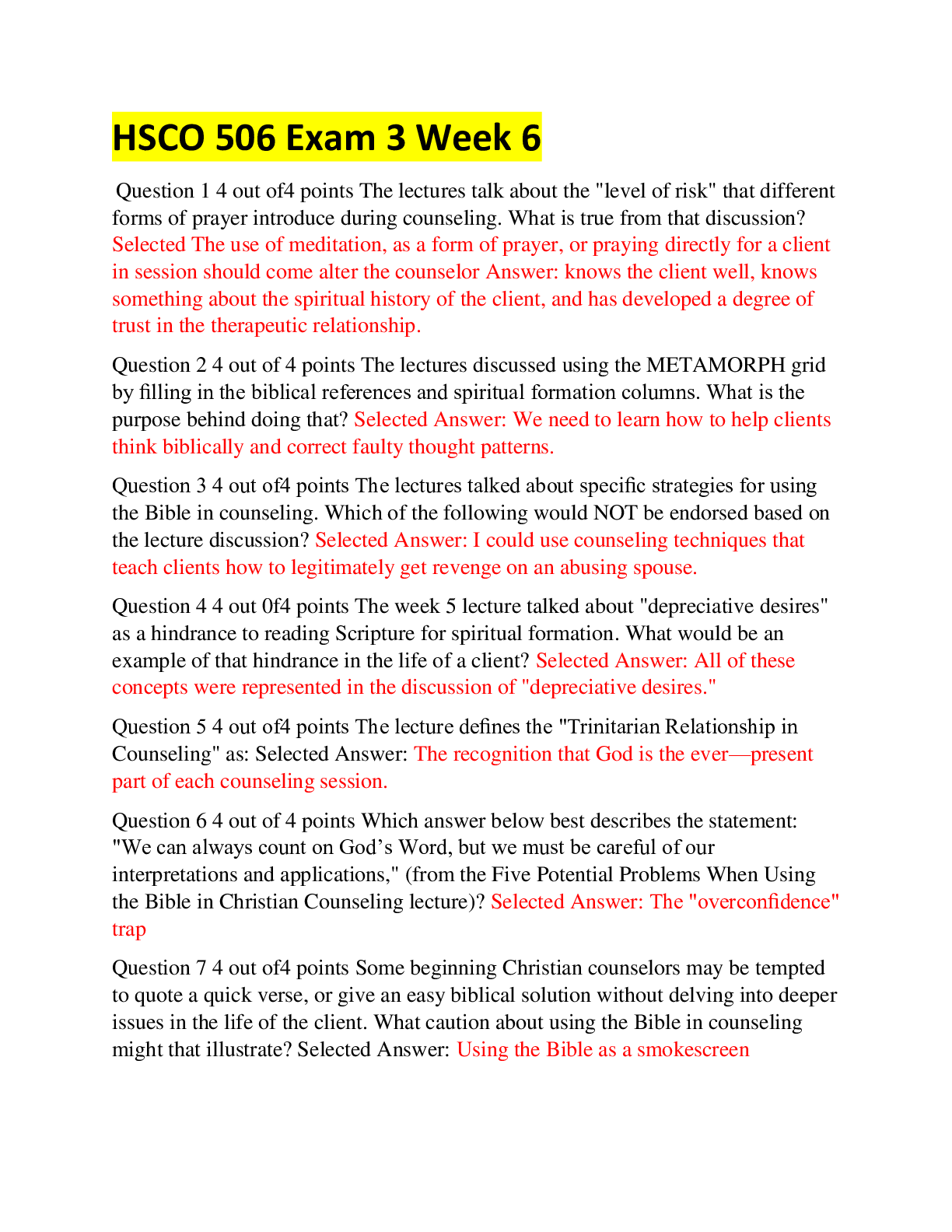

.png)





